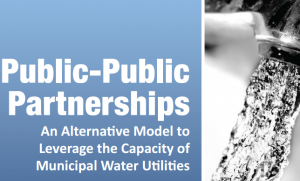Public-Public Partnerships Provide Affordable, Efficient Drinking Water and Sanitation to Cash- and Resource-Strapped Communities
Brussels - Solving the tragedy of almost 900 million people around the globe lacking access to safe water, and 2.6 billion lacking access to sanitation requires innovative solutions to fixing inadequate and underfunded infrastructure. But a new report released today by the consumer advocacy group Food & Water Europe highlights how public-public partnerships have successfully and inexpensively provided these critical resources to communities around the globe. Public-Public Partnerships: An Alternative Model to Leverage the Capacity of Municipal Water Utilities, shows that municipalities can forge partnerships with one another to efficiently deliver drinking water and wastewater service while ensuring that these resources are kept under public control.
New Food & Water Europe Report Shows that Municipalities Can Collaborate, Avoid Privatizing Assets
 Brussels – Solving the tragedy of almost 900 million people around the globe lacking access to safe water, and 2.6 billion lacking access to sanitation requires innovative solutions to fixing inadequate and underfunded infrastructure. But a new report released today by the consumer advocacy group Food & Water Europe highlights how public-public partnerships have successfully and inexpensively provided these critical resources to communities around the globe. Public-Public Partnerships: An Alternative Model to Leverage the Capacity of Municipal Water Utilities, shows that municipalities can forge partnerships with one another to efficiently deliver drinking water and wastewater service while ensuring that these resources are kept under public control.
Brussels – Solving the tragedy of almost 900 million people around the globe lacking access to safe water, and 2.6 billion lacking access to sanitation requires innovative solutions to fixing inadequate and underfunded infrastructure. But a new report released today by the consumer advocacy group Food & Water Europe highlights how public-public partnerships have successfully and inexpensively provided these critical resources to communities around the globe. Public-Public Partnerships: An Alternative Model to Leverage the Capacity of Municipal Water Utilities, shows that municipalities can forge partnerships with one another to efficiently deliver drinking water and wastewater service while ensuring that these resources are kept under public control.
“All too often, communities that cannot afford to maintain their own drinking and wastewater systems are forced to sell or lease them to private entities, which often provide subpar service at higher rates,” said Food & Water Europe Executive Director Wenonah Hauter. “Public-public partnerships allow communities to avoid the woes associated with privatized service and ensure that essential drinking water supplies and sewer systems stay in the public’s hands.”
Under a public-public partnership, two or more water utilities or non-governmental organizations pool resources, buying power and technical expertise. Such partnerships provide the same advantage that a private utility could deliver without the workforce reductions, poor customer service, rate increases and service interruptions that private utilities are notorious for. Because such partnerships do not involve investors who expect a cut of the savings, efficiencies generated are reinvested into the system, not shareholder bank accounts.
Public-public partnerships can be successfully implemented on a variety of scales—within nations, across national boundaries and between industrialized nations and developing ones. Some examples include:
- The Baltimore Regional Cooperative Purchasing Committee, a group of communities in Maryland saved $1.5 million in 2010 by partnering with one another.
- In Puerto Cortés, Honduras, a partnership among five civil society groups created a new water utility that was eventually able to provide water to 98 percent of the city’s residents 24 hours a day whereas the city’s old water utility only delivered water to 79 percent of residents, 14 hours a day.
For communities in the developing world, these partnerships can serve as the foundation for sustainable economic development. Partnerships between water systems in industrialized nations and those in developing countries can improve water quality and allow parties to share best practices. Industrialized countries can provide management and technical expertise in these cases while ensuring that costs are kept low for consumers. This model has been particularly successful in Africa, where over half a dozen cross-border utility partnerships have been forged since 1987.
The European Commission recognized the advantage of such cross border partnerships by designating €40 million in 2010 for establishment of non-profit water and sanitation sector PUPs in African, Caribbean and Pacific countries. Importantly, the EU Water Facility guidelines specifically bar profit-making endeavors, thus precluding public-private partnerships from receiving grant funding.
“Tight economic times often mean that communities have a hard time maintaining their drinking water and sanitation systems, and through austerity measures are being forced into leasing or selling these assets to private entities in order to receive bail outs. But privatization has already proven to be a failure. Public-public partnerships are a cheap, efficient method of providing essential drinking water and wastewater services. Governments around the globe should implement policies to facilitate them,” concluded Hauter.
For more information, please contact:
Gabriella Zanzanaini, gzanzanaini(at)fweurope(dot)org, +32 488 409 662


